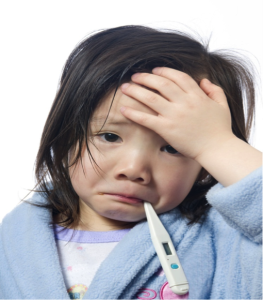The Risks of High Fever in Young Children (High Fever in Toddlers)
When your little one is sick you always want to have the best information. Children often get ill throughout the year due to child care centers or older school age siblings. Illness is just an unavoidable part of life. In fact children may have multiple colds throughout the first years of life that will lead to ear infections or other conditions that will cause fevers. Although a high fever can be concerning for any parent. Young children can be especially vulnerable to the effects of fevers and may present signs that should be addressed by your pediatrician. We’ll talk about these signs here along with ways to manage your child’s temperature or the effects of a fever.
Causes of High Fever in Young Children
 The most important thing to remember with any fever is that the body raises the temperature to help fight of infections or illness more quickly. Fevers in themselves are not dangerous to individuals of any age. However when your child has a temperature over 102.0 it is cause for concern. The first thing to do is to do a bit of detective work to figure out why your child has a fever. This will likely involve a visit to your child’s healthcare provider. However, if it’s the middle of the night you may need a more immediate plan to manage those pesky fever symptoms.
The most important thing to remember with any fever is that the body raises the temperature to help fight of infections or illness more quickly. Fevers in themselves are not dangerous to individuals of any age. However when your child has a temperature over 102.0 it is cause for concern. The first thing to do is to do a bit of detective work to figure out why your child has a fever. This will likely involve a visit to your child’s healthcare provider. However, if it’s the middle of the night you may need a more immediate plan to manage those pesky fever symptoms.
Preventing Complications due to High Fever in Young Children
Young children are particularly prone to dehydration and should be encouraged to sip fluids throughout the day to prevent dehydration. If your child has diarrhea and vomiting as well the risk of dehydration is doubly concerning. Pedialyte is a wonderful way to help your child stay hydrated. Popsicles and ice chips may also be beneficial is your child is reluctant to drink or is experiencing a sore throat. Some parents have even had luck with freezing small pieces of fruit into ice cubes in inexpensive trays to coax their children into staying hydrated.
Managing High Fever in Young Children
You should try to keep your child cool as well. Toddlers should ideally be in only their diaper or underwear and under light linens such as a sheet during the night then dressed in light clothing during the day. You may also want to give your child a tepid sponge bath as well to help decrease the fever. Take care to prevent shivering though because this will increase body heat and drive the fever up again. Tylenol or other fever reducers may also be appropriate for your child, but always check with your doctor first.
Home Care of High Fever in Young Children (High Fever in Toddlers)
As a parent fevers can be very concerning, especially in the middle of the night. While it’s always best to consult your healthcare provider there are a few steps you can take to keep your child comfortable in the meantime. Be sure to give lots of fluids and keep your child dressed lightly. Do not wrap your child in heavy blankets as this will drive up the fever quickly. Tylenol or other fever reducers may also reduce the fever and provide pain relief for your child. If your child becomes lethargic, confused, or does not urinate in 8 hours be sure to seek emergency medical attention.
If you have a baby with a high fever see Fever Remedies for Babies.